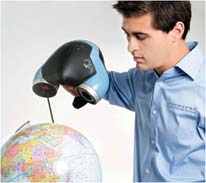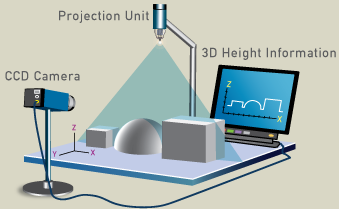(Note: This page could benefit from an image closer to the top - perhaps a laser scan of a building along with a caption)
The 3D documentation and visualization of objects relating to cultural heritage and the arts is an expanding application area. There are two main kind of instruments which are employed: laser scanners (LS) and structured light devices (SL). Laser scanners are used for big objects - from historical building sites to statues. Structured light devices are used for fine art objects, such as paintings. The selection of the right technology for these kinds of applications is very important and strictly related to the project requirements, budget and user’s experience.
LS- Laser scanning
3D laser scanning technology is particularly well-suited for recording landscapes, especially when making detailed inventory records that need to be accomplished rapidly. 3D models are generated during evaluation, as well as the usual contour line maps and detailed records of the vegetation, trees, rocks, etc in the area. Additional information such as aerial feature photographs and geophysical investigations can also be integrated into the 3D model.
Accurate plans of monuments and old buildings are notoriously rare. Laser scanning provides an economical solution for making basic surveys (ground plans, cross sections) as well as for recording the complex measurements of distorted buildings. Exterior walls and interior spaces can be completely documented in three dimensions and with an accuracy of 0.5 to 2.5 cm. Ground plans and cross sections can be created at any point throughout the entire building. All of this is made possible by the use of a combination of total station surveying (polygons), systematic laser scanning and, when required, additional photogrammetry recordings. During the computer-supported evaluation of the survey data, CAD plans are created which can incorporate ground plans and cross sections. The data can be digitally transferred into all standard formats. It is also possible to generate a three dimensional model of the building that is being documented. This method of surveying 3D data is much more rapid and economical than any other system. Laser scanning also unlocks huge potential in the field of post-processing. When appropriate 3D software is used, real color information can be incorporated into 3D models to create accurate, photo-realistic, three dimensional illustrations of the surveyed objects.
Laser scanning cave art to create a 3-D virtual visit
Watch how laser scanning technology is used to create a 3-D virtual tour of a cave that allows viewers worldwide to explore prehistoric cave art.
Laser scanners have been used to create virtual models of art and archaeological objects, as well as virtual models of of huge spaces, such as caves covered with prehistorical paintings. In the case of the Ekain cave paintings, the colors as well as the high relief of the cave ceiling are replicated on a 1:1 scale. The need for preservation was the main motivating factor in this work. The original caves were being damaged by the rapid fluctuations of RH (relative humidity) caused by tourist groups, because the presence of humans is very humidifying in enclosed spaces. RH fluctuations increase the damage caused by salts on cave and tomb paintings. Laser scanning the cave art also had the added benefit of documenting the pigments colors in their current state of preservation before the additional deterioration occurs. The replica provides a suitable alternative that allows for unlimited tourist access. Similar technology was used to duplicate Egyptian wall paintings. Portable panels were made that toured the world, providing access to viewers who may never have been otherwise able to view Egyptian tombs.
How it works
For the past few years, 3D laser scanning systems have been employed very successfully in industrial surveying as well as in the design and manufacturing industries. These scanning systems allow the user to survey structural surfaces and three dimensional bodies. The data is then transferred to a computer where it is converted into accurate three dimensional models. The high quantity and precision of the measured points enable the user to generate realistic, 3D illustrations of complex structures.
A basic laser scanner system involves a laser range finder reflected by a rotating mirror. The laser is scanned around the scene being digitised, in one or two dimensions, gathering distance measurements at specified angle intervals.
The laser range finder
3D scanning devices employ many different technologies, among which the laser scanner is the most used when high range of detection is required at the expense of resolution, as is the case in architecture 3D modeling. The laser scanner emits a pulse of laser light and the amount of time before the reflected light is seen by a detector inside the scanner is timed. Since the speed of light is known, the round-trip time determines the travel distance of the light, which is twice the distance between the scanner and the surface. Therefore, the distance scanner surface can be easily calculated. Then, the direction of the next emitted laser pulse is changed by using a system of rotating mirrors.
Technical details
Laser scanning devices cost in the range of hundreds of thousand of dollars, but they are very easy to deploy. Among the non-contact and presently used 3D measuring systems, laser scanners better combine high resolution and good versatility. This makes laser scanners suitable for in situ applications. Laser scanner systems are characterized by simple hardware and daylight working capabilities.
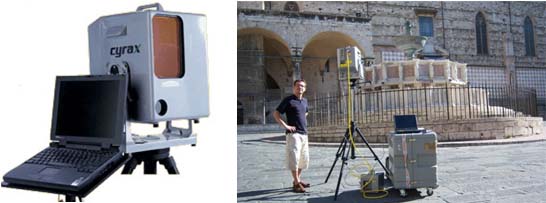
Reconstructing a 3D model of a medieval fountain in Italy is a very easy task with a laser scanner.
SL- Structured light
This technique is used in order to detect and document craquelure and brush strokes. It is also particularly useful for the restoration of a painting’s wooden supports, because by measuring the profile of their surfaces, SL provides precise information on the deformation undertaken by the wood.
Use structured light to observe brush stroke details and discover thin paint layers.
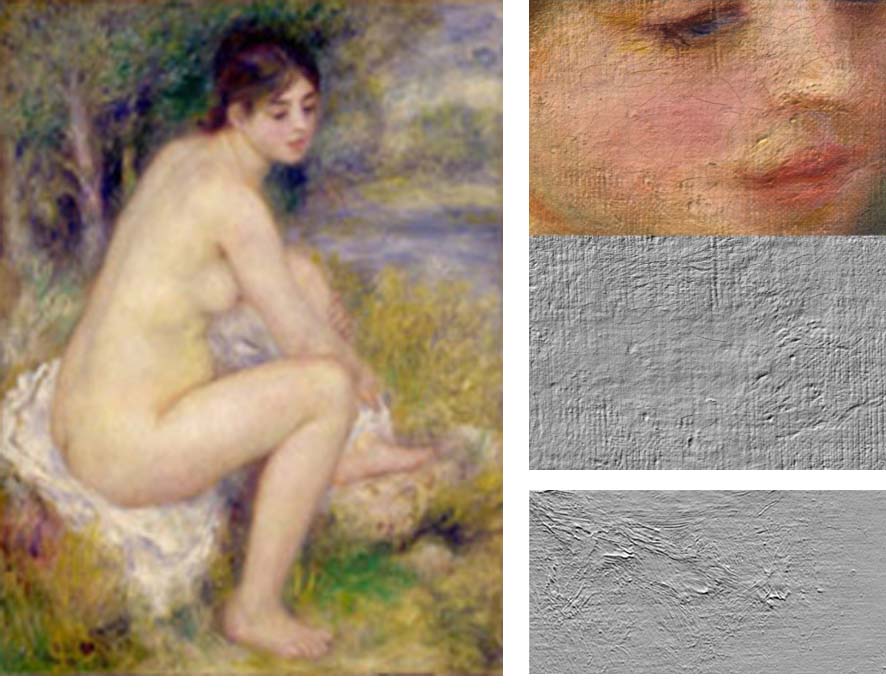
In the detail of the face of Renoir’s 1883 painting, Femme Nue Dans une Paysage, the craquelure is clearly visible in the color image. This craquelure is all you can spot with naked eyes. Look now at the shaded monochrome image of the same detail acquired with a structured light scanner (right). You can see the same craquelure but also something more. The canvas has a slight relief due to a thin paint layer. Brush strokes can be spotted, as well as other details.
Pierre-Auguste Renoir, Femme Nue Dans une Paysage,1883, Musee de l'Orangerie, Paris. Left, visible image of the painting. Right top, detail of face, visible image and 3D shaded model. Right bottom, detail in 3D shaded model.
3D digital Archaeology
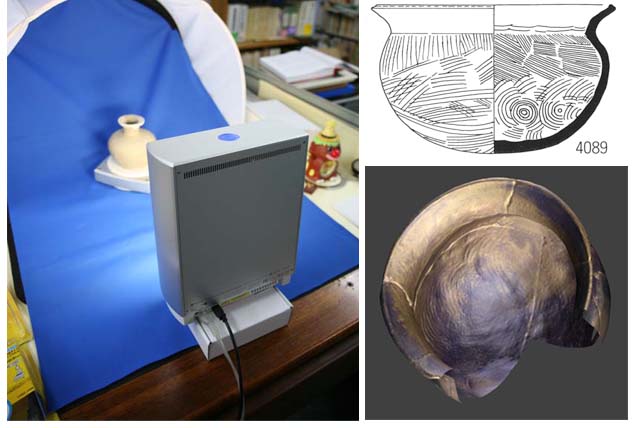
Scanning a ceramic with structured light (left) allows art historians to reconstruct 3-D models of the pottery (bottom right), including textural details, which is far more informative than the 2-D representational drawings of ceramics (above right) that were once the norm.
The majority of ceramic reproductions are published as two-dimensional drawings in books and articles. Consequently, they lose key three-dimensional information on these vessels. Structured light scanners and various software programs can be used to create 3-D reconstructions of artifacts. This practice will allow art historians to systematize their collections and input pottery and other artifacts into 3D databases, which would make these finds visible to researchers worldwide over the Internet.
How it works
Structured light is the projection of a light pattern (plane, grid, or more complex shape) at a known angle onto an object. This technique can be very useful for imaging and acquiring dimensional information. The most often used light pattern is generated by fanning out a light beam into a sheet-of-light. When a sheet-of-light intersects with an object, a bright line of light can be seen on the surface of the object. By viewing this line of light from an angle, the observed distortions in the line can be translated into height variations. Scanning the object with the light constructs 3-D information about the shape of the object. High definition structured light 3D-scanners, optimized for the requirements of arts and cultural heritage, allow the 3-dimensional digitization of art objects and paintings with high resolution and accuracy. Moreover, the texture and/or color of the object can be recorded, offering a one-to-one correspondence of 3D coordinates and color information.
Structured light scanners are based on the principal of optical triangulation using structured light: A special projection unit projects a known pattern of light onto the object. A digital camera records the image of the object together with the projected pattern. A video projector is used to project structured light patterns on the object to be scanned. The digital still camera is used to acquire images of the object under structured lighting. Both devices are driven by a software tool running on a standard PC, which produces the series of patterns projected by the emitter and drives the camera. Photos are taken to acquire images of the distorted patterns (from which the geometry is reconstructed) and images of the object under different illumination conditions (from which the illumination-invariant color, or albedo, of the object surface is reconstructed).
Technical details
Structured light devices are much less expensive than laser scanners. Their cost starts from a couple of thousand of dollars. They are also far more portable and smaller than laser scanners.
